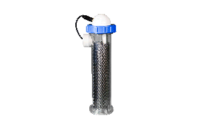27
Jun 2019
How to Clean your Watermaid Cell
Watermaid Cell Cleaning is an important part of your chlorinator maintenance. Watermaid cells naturally pull calcium and other metals out of the pool water. This is a co-reaction of chlorine production and as long as you do not allow the calcium deposits to accumulate and restrict water flow there are no problems with this. If on the other hand calcium builds up in the cell, the water flow through the cell is restricted. The water flow cools the electrodes which are the centre tube and the mesh inside of the cell. If the electrodes overheat it can warp the cell and it will leak. At this point, the cell will need to be replaced. Pool stores add to our grief by selling us calcium and calcium containing products like granular shock and granular acid. All of these products will make it necessary to clean the cell more often.

There are other posts that talk about the addition of epsom salt to help with calcium deposits and the problem with adding calcium to a pool.
When calcium builds up the cell will need to be cleaned in 1 of 2 ways. It can be acid washed or mechanically cleaned.
Acid Washing
There are commercially available cell cleaning solutions that you can find at your pool shop. These are typically a mixture of muriatic (hydrochloric) acid and water. It is usually a 4 to one solution which is needed for plate type chlorinators. The down side to these solutions is that they are a little too strong for my liking and can dissolve the plating in the cell. A Watermaid cell is more open so if you choose to use these solutions, I suggest that you dilute the solution by adding equal parts of water.
Home made acid solution
You can also make up you own acid solution for cleaning the cell by adding one part muriatic acid TO 10 parts water. You MUST add the acid to the water NOT the other way around.
Cleaning procedure Acid wash
First turn off your pool pump and the chlorinator.
To clean your cell, disconnect it at he the bottom by turning the white (or Blue) barrel nut clockwise if you are looking down from the top of the cell.
You usually do not have to disconnect the grey cable from the power supply. Remove the cell and place it upside down in a plastic bucket. Fill it with the acid solution and leave it to fizz and dissolve the calcium deposits. If you have time, leave it over night.
When the deposits are cleared, dispose of the acid solution and rinse the cell out with a hose. It is usually best to completely disassemble the cell and wipe off the centre tube (cathode) to remove any remaining deposits.
Reassemble the cell, turn on the pump and chlorinator and you are are all finished.
Mechanical Cleaning
This is my preferred method. It doesn’t take away from the precious metal plating on the mesh and the cell will last longer.
Turn off the pool pump and the chlorinator.
At the top of the cell you will see a black wire coming out of the side of the cell and is plugged into the top dome of the cell. This is simply a brass pin which inserts into a brass socket in the dome. It is a straight pin with no key-way so you can wiggle it a bit to help get it out.
If the brass pin is corroded you should clean it off with fine sandpaper or emery cloth. I also roll up a piece and clean out the brass socket as well. At this point it is a good idea to lubricate the brass pin and socket with dielectric grease which is grease you can get at any automotive store for the battery terminals on your car. It helps to prevent corrosion and make it easier to remove the pin the next time you want to clean the cell.
With the brass pin removed, unscrew the top barrel nut on the cell by turning it counter clockwise if you are looking down on the cell.
Grab the dome on the top of the cell wiggle it and pull out the centre part of the tube.
At this point you will have the cathode removed,which is the part that attracts the calcium deposits.
The cathode can be cleaned by simply scraping off the deposits with a plastic or wooden scraper. DO NOT scrape the mesh part of the cell. This will damage the plating. The centre tube is pure titanium and is tough. You can scrape it and not hurt it.
You can also crumble off the deposits with a rag.
Reassemble the cell, turn on the pump and chlorinator and you are finished.